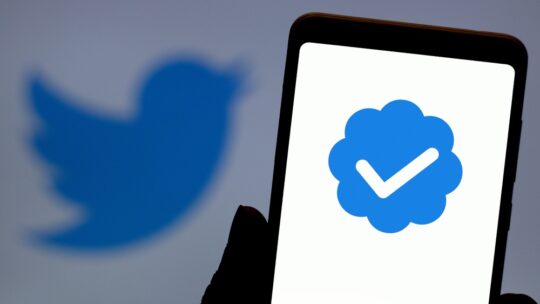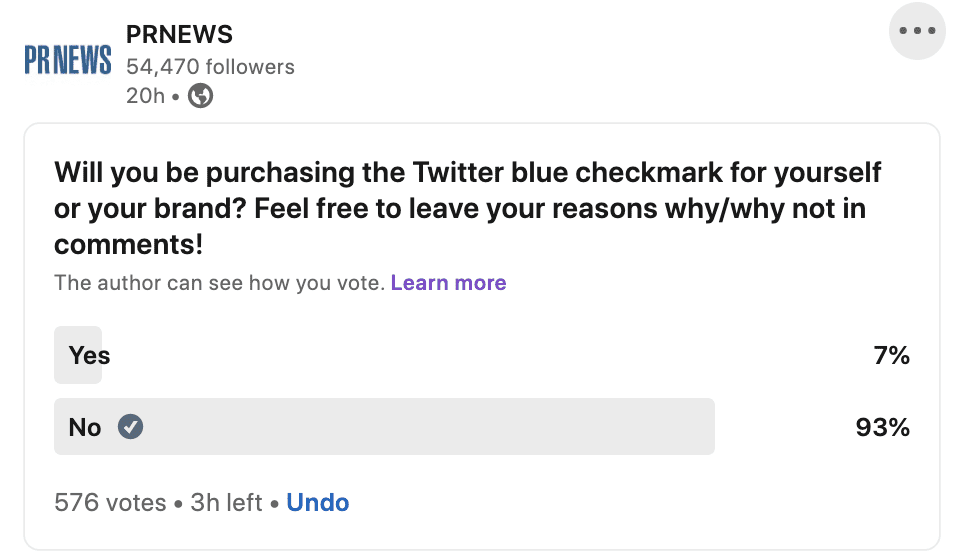
Elon Musk can’t stay out of the headlines since his purchase of Twitter. Whether you're an avid user, visiting Twitter for clients or have never logged on, you likely know the platform's blue check mark is a badge of authority. Musk's insistence on changing rules for the blue check mark program is raising concern about identity theft and misinformation. As such, it's a dilemma for corporations and communicators.
Musk plans on charging $8 a month for a subscription to Twitter Blue, which includes fewer ads, the ability to post longer videos, priority for posts and a blue check mark.
However, this seems to mean anyone spending $8 per month can get a blue check mark. Previously, Twitter vetted those seeking check marks.
In informal Twitter and LinkedIn polls conducted by PRNEWS, a majority said they will not be purchasing the check mark for themselves or those they represent.
Will you or your brand be purchasing a blue checkmark? Reply with any comments.
— PRNEWS (@PRNews) November 7, 2022

Why the Blue Check Mark Matters
Twitter began verifying accounts with its blue check mark in 2009, after former baseball manager Tony La Russa sued over a fake account. The resulting verification program included not only celebrities, but politicians, government organizations, brands and journalists.
Its goal was stopping misrepresentation and impersonators. The blue check built trust for users and followers, as it confirmed that a tweet's source was genuine.
Verification is particularly important when tweets include vital information. For example, authorities tweet information during emergencies. In addition, tweets are deployed, answered and shared during natural disasters or when locating missing persons and tracking criminals.
Results of the $8 Option
Buying a blue check disassembles the original program's purpose. Anyone can create an account, buy a check mark and say they are that person—without verification. This is causing concern for public figures and brands.
However, in response to user and Twitter employee concerns (and possibly because of mass layoffs, i.e. no one to create or launch products), Twitter is delaying the program until Nov. 9—after midterm elections. This should maintain trust for verified accounts and reduce impersonators as the nation votes on Nov. 8.
The delay also comes after some celebrities protested and began tweeting as Elon Musk. They uploaded Musk's picture and changed their Twitter profile name to “Elon Musk.”
In response, some, like Sarah Silverman and Kathy Griffin, found their accounts suspended.
Musk clarified the rules in a tweet.
Going forward, any Twitter handles engaging in impersonation without clearly specifying “parody” will be permanently suspended
— Elon Musk (@elonmusk) November 6, 2022
However, suppose people opt out of the pay-for-blue-check mark program. It's unclear how Twitter will combat impersonation and misinformation without a formal verification process.
“A blue check mark [used to] mean access to an authentic account," says Nkongho Beteck, director social media and digital content, National Retail Federation. "If there’s more than one Twitter user with a famous name and a blue check mark, it will be hard to know which profile is real,” Beteck adds.
How Brands Should Prepare
In addition, brands and public figures use Twitter for customer service. What happens if multiple verified accounts exist for a brand or organization? Or if people reach out to bogus accounts? How can brands continue to maintain their audiences’ trust on Twitter?
MikeWorldWide is encouraging caution, but is not advocating abandoning ship—especially for companies using Twitter for customer service, says Megan Hueter, SVP, digital.
“We believe this state of Twitter, as well as other macro media landscape changes, may force more brands to really think about their cross-platform channels, especially the investment in owned/direct distribution (newsletters, Discord channels, etc.).”
Hueter also is encouraging companies to monitor for fake accounts.
“Our agency executes cross-platform social listening around many brands as part of reputation management, and this is often where we see impersonated accounts bubble up, if they exist.”
The apparent lack of blue check verification is especially concerning before the holidays, when customer service inquiries surrounding travel, shipping, toy assembly and burning turkeys flood the timeline. And it’s more than fake brand accounts. Companies should consider bogus customers.
“Confirming an order number, email address or phone number is just one of the ways to vet customers properly,” Beteck says.
Companies and public figures have options for maintaining trust in their Twitter feeds. “Add personalized branding like a watermark to your Twitter banner or even upload a watermarked image with all of your posts," Beteck says. "Link to your website or other social channels where a user can verify that it’s you.”
Trust Impact for Twitter
Nobody knows what will happen when Twitter’s $8 blue check option goes live, but managing trust will remain an issue. Hueter says Twitter must proactively address security concerns.
“In terms of identifying and managing impersonation, it will continue to be critical for Twitter to maintain and enforce a standard policy for addressing these issues that is the same for each user no matter how influential they are,” she says. “Right now, trust and transparency are on the docket for Twitter...getting this right will be critical.”
Nicole Schuman is senior editor for PRNEWS. Follow her @buffalogal
